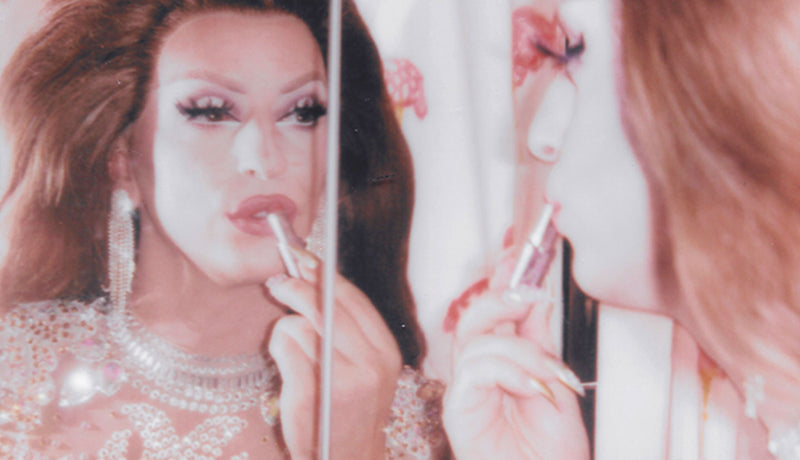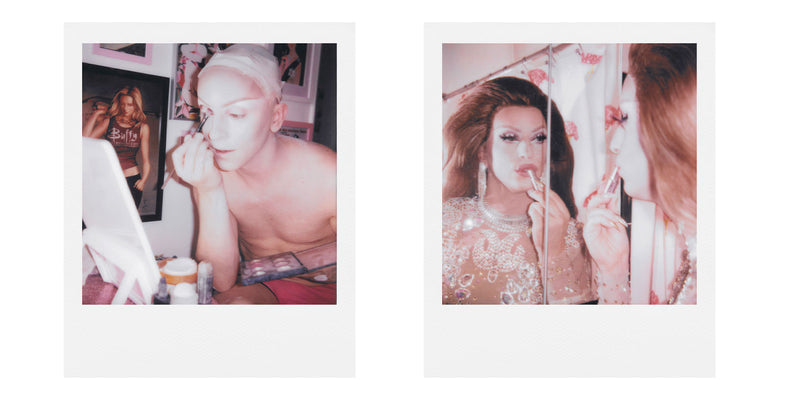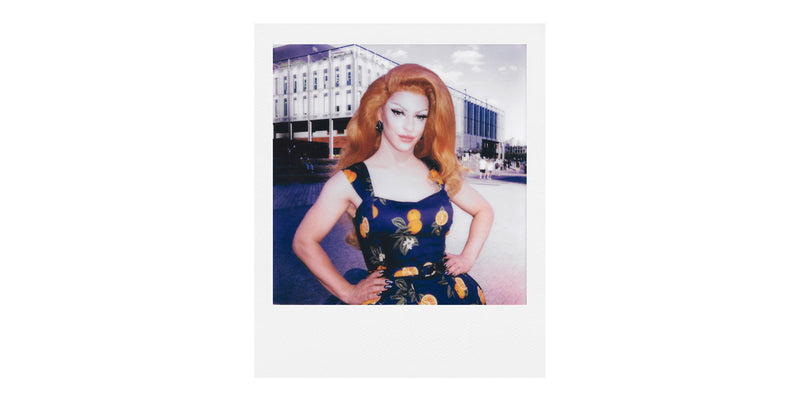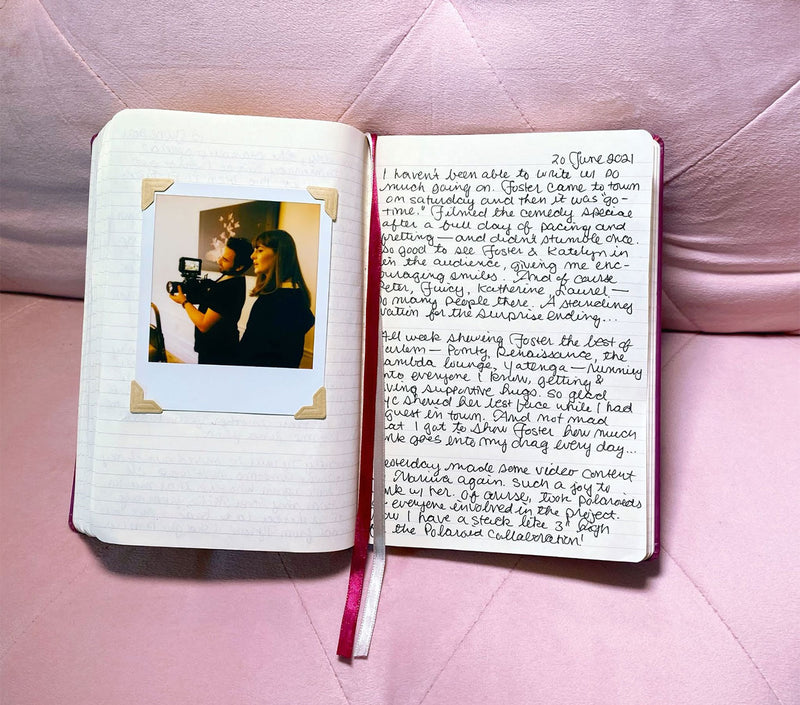

Miz Cracker (@miz_cracker) is a drag queen, former RuPaul's Drag Race contestant, writer, comedian, podcast host, and much much more. In fact, Miz Cracker is also a Polaroid devotee. We got to speak to the iconic queen about inspiration, identity, and finding calm in creativity.

Developing: How did you develop the Miz Cracker look and persona? Who and what inspired you, and what was that process like?
Miz Cracker: When I started drag, I went by the name Brianna Cracker as a nod to my favorite snack, brie on a cracker. With my name, I was kind of declaring that my drag would be about joy and pleasure and indulgence. I wanted to bring all my favorite things together in one place. So I did. I combined 1950s couture with Sci-Fi fashion, combined comedy with my passion for food, and topped it all off with a lot of blonde hair. I essentially just tried to make myself happy, hoping that my happiness would rub off on other people as I strolled by. I was inspired in large part by my drag mother, Bob the Drag Queen, who taught me that drag can make the world a better place—if you use it right.

A beautiful portrait of me at the South Street Seaport, snapped at sunset by the one and only Katelyn May Groettum. Katelyn has been my close friend and manager for nearly six years—and no one captures me with a camera like she does.
D: What else inspires you?
MC: Everything that I do is inspired by things I see on the street in New York. When it comes to my drag, sometimes I’ll literally pick up a piece of glittery trash from the sidewalk and incorporate it into a garment. And when it comes to photography, I’m always looking at the amazing colors around me in the city, seeking that perfect backdrop for a Polaroid portrait or still life. The city is always fueling my creativity.
Translation missing: en.<i>Nothing says summer like fire hydrants gushing water. This hydrant is near my work studio in the South Bronx, which served as a stage for my digital performances during the pandemic.</i>
Translation missing: en.<i>Anthony Sociedade (<a href="https://www.instagram.com/nurseanthony" target="_blank" rel="noopener noreferrer">@nurseanthony</a>) is a Registered Nurse and serves as Patient Care Director at a major hospital in Manhattan. He was a frontline worker throughout the pandemic.</i>
Translation missing: en.<i>A view of Hell's Kitchen from above. Hell's Kitchen is well known as a queer friendly neighborhood, and is home to dozens of LGBTQIA+ owned restaurants, bars, performance venues, not to mention thousands of queer people from every walk of life.</i>
Translation missing: en.<i>Tsilala Brock (<a href="https://www.instagram.com/tsilalabrock" target="_blank" rel="noopener noreferrer">@tsilalabrock</a>), performer and writer.</i>
D: What role does creativity play in your life?
MC: Before the pandemic, I had started thinking of my creative life as my day job—a way to pay the rent on my little studio apartment. But after Covid shut everything down, my creative work became my therapy. With so much negativity and ugliness in the world, I suddenly felt compelled to contribute a little beauty. So I picked up a Polaroid camera—or three—and started capturing images of everything that made me smile. People. Graffiti. Sunset light on buildings. I started using my creativity to fashion an alternate world where everything is wonderful.
“After Covid shut everything down, my creative work became my therapy.”
D: What does instant photography mean to you, and why do you enjoy it so much?
MC: Anyone that knows me knows that I am obsessed with instant photography—specifically Polaroid photography. I carry at least two different kinds of Polaroid cameras with me wherever I go. Because I love documenting the people and places I love most. And I love having a physical keepsake from my favorite experiences. Of course I love digital photography too—but come on, there’s nothing more magical than snapping a couple photos of a friend, and then standing side by side to watch as they develop. It’s so exciting. And then both of you have a little something to walk away with, something to put in a scrapbook or post on the fridge. Suddenly a fleeting moment is a tangible thing, something you can hold in your palm.
Translation missing: en.<i>Mila Jam (<a href="https://www.instagram.com/themilajam" target="_blank" rel="noopener noreferrer">@themilajam</a>), Performer and Activist.</i>
Translation missing: en.<i>Jasmine Rice LaBeija (<a href="https://www.instagram.com/jasminericenyc" target="_blank" rel="noopener noreferrer">@jasminericenyc</a>), a drag queen and trained opera singer, after performing some of her favorite arias at the Solomon R. Guggenheim Museum as part of the Works & Process performing arts series.</i>
Translation missing: en.<i>Brendt White (<a href="https://www.instagram.com/rokay3000" target="_blank" rel="noopener noreferrer">@rokay3000</a>) is a fixture in New York City nightlife. At the end of the pandemic, we were finally able to join each other for lunch after a long hiatus. It was a beautiful day—the light was just right for a Polaroid.</i>
D: How does journaling contribute to your creative process?
MC: Journaling is yet another form of therapy for me. I’m an anxious person, so there are always negative thoughts swirling through my mind. But writing them all down on paper is a huge help. When all my worries are contained in a single page, they don’t look so bad. And when I’m done writing, I can move on to think about happier things. I guess what I’m saying is that journaling clears space in my head for dreaming and creating. Without it, I’d just be curled up in bed, stressing. Over the past year, I’ve started pasting my favorite Polaroids into my journal as well, so I can look at my diary and say, “Hey, life isn’t so bad—look what a nice day you had.”

A Polaroid photo accompanie’s Miz Cracker’s diary entry.
“So take the pressure off of yourself. You don’t need to worry about deciding who you are. You just need to have a passion for exploration.”
D: What would you say to young people who are still searching for their identity?
MC: I would say get ready for a lifetime of searching. When it comes to my gender, my sexuality, my career, my fashion sense, I have never been able to truly define myself. I’m always changing my mind and heart. And if I look at my mentors—my biological mother, my drag mother, my close friends—I see that they’re all constantly going through the same process. So take the pressure off of yourself. You don’t need to worry about deciding who you are. You just need to have a passion for exploration.
Translation missing: en.<i>I met the gorgeous Angelica Torres (<a href="https://www.instagram.com/angelicactorres" target="_blank" rel="noopener noreferrer">@angelicactorres</a>) at the Proud to be Me party.</i>
Translation missing: en.<i>Ran into Stella D’oro (<a href="https://www.instagram.com/stellaqueenmum" target="_blank" rel="noopener noreferrer">@stellaqueenmum</a>) and of course had to capture her on Polaroid.</i>
D: If you could put a massive billboard on all the major Pride parade routes, what would the billboard say?
MC: My billboard would say “Know Yourself.” Because I think, so often, we get a little too concerned with what other people are doing, and saying, and being. Sometimes we need a reminder to keep our noses out of other people’s lives and focus on what we’re truly responsible for—ourselves. Explore yourself, challenge yourself, educate yourself. That’s the easiest and most important step toward making the world a better place—right now.
Miz Cracker and Polaroid have made a donation to Black Queer Town Hall, a non-profit organization which celebrates Black queer excellence through community events to uplift Black queer voices and share knowledge. Find out how you can get involved at www.blackqueertownhall.org.